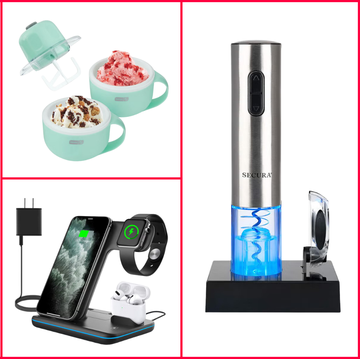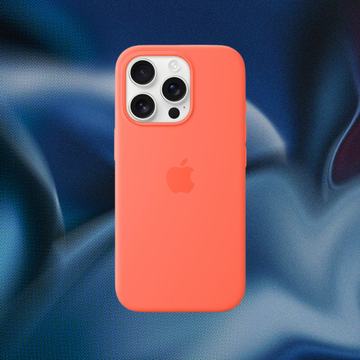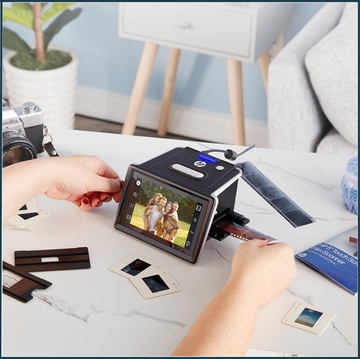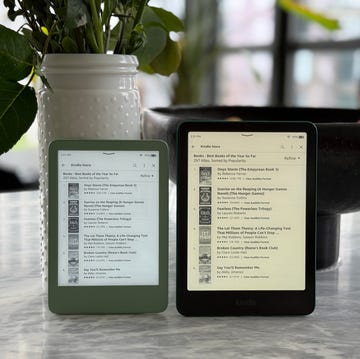Whether you're tired of being glued to your phone, need a quick way to respond to texts or you're curious about your heart rate during a HIIT class, smart watches are one of the most convenient ways to stay connected while also tracking health metrics, activity and overall wellness. But with so many models out there, it can be trickier than ever to choose the right one for you. To help you better understand some of the key differences between two of the most sought-after smart watches on the market, Garmin vs. Apple Watch, our pros dive deeper into each watch below and some of their key differences.
The product analysts and engineers at the Good Housekeeping Institute’s Media and Tech Lab have tested wearables like smart watches for women, smart watches for men, fitness trackers, smart rings and more for years. We’ve been hands-on with at least 15 smart watches over the past year alone and continuously review the latest models consumers rave about, including the Apple Watch Series 9 and top-performing Garmins. Ahead you’ll find everything you need to know about Garmin vs. Apple Watch to help you determine which smart watch is the best fit for your wrist.
Garmin at a Glance: Fitness First
Garmin smart watches put fitness front and center, making health analytics, activity tracking and training metrics and resources available on all of its latest models. It’s just one of the reasons why runners and fitness enthusiasts are drawn to the brand. With the press of a button or a simple swipe on the screen, you can view your heart rate, step count, body battery, sleep score and so much more, with even more analytics available in the Garmin app itself. But what we love most is that Garmin smart watches feature an activity list that’s more extensive than what you’ll find among other smart watch manufacturers, meaning you’ll likely be able to track everything from running to more niche activities such as badminton or kiteboarding. Our pros were wowed by just how many activity profiles were available on the epix Pro (Gen 2) that we recently tested.
And just because Garmin leans heavily on fitness, that doesn’t mean you won’t have access to features such as texts, notifications, news or app updates, music, weather status and more. But before purchasing a Garmin, our pros recommend double-checking the features your desired model offers as not all of Garmin’s watches are made equal. Some of the most popular series include the Venu, Forerunner, Instinct, epix, fenix and vivoactive, with plenty of picks (including hybrid smart watches) for those looking for style or fashion, analytics and multisport performance.
For an in-depth comparison of Garmin smart watches, head to our review of the best Garmin watches.
Apple Watch at a Glance: Seamless Navigation
The Apple Watch immediately stands out for its intuitive touch interface and bright Retina display reminiscent of other Apple devices. While the interface has a striking resemblance to that of an iPhone, the Apple Watch is unique in what it offers. Not only can you receive texts and answer calls from your wrist (assuming your phone is in range or you’ve paid for a cellular plan), but you’re able to access the majority of your favorite apps, health data, voice assistance from Siri, calendars, music and more. Though it can’t replace your phone entirely, it gives your hands a break from clinging to your device throughout the day. "The main reason I got the watch initially was because I wanted to be reachable without having my phone in my hand at all times," says GH Institute Director of Strategy & Operations, Lexie Sachs. "Whether I was in workout classes, work meetings, etc. where I didn’t have my phone out, I wanted to be able to see if any urgent calls (mainly from my kids' school or camp) were coming through."
Much like Garmin, you can track activity and workouts on your Apple Watch via the Workout app, as well as keep track of vital health metrics such as heart rate, heart rate variability, blood oxygen, sleep and more. All your data is easily accessible via Apple Health and compiled in a digestible format.
While there have been a variety of Apple Watch iterations over the years, the latest generation is the Apple Watch Series 9, which runs on watchOS 10. Other Apple Watches to consider are the Apple Watch Ultra 2 and the Apple Watch SE. While the SE is the most affordable and the Ultra boasts a more rugged design, premium features and extended battery life, the best choice for most is the Apple Watch Series 9.
For more help deciding between the three, you can check out this comprehensive comparison chart of the SE, Series 9 and Ultra 2 watches on Apple's website.
Garmin vs. Apple Watch
Battery Life — Garmin
When it comes to battery life, there’s no denying that Garmin is a few steps ahead of Apple. Though claimed battery life varies from model to model, the average battery life of most Garmin smart watches ranges from 5 to 34 days, according to the brand (there's even one model that claims to last a year). Garmin owners rarely find themselves worrying about charging their devices in the way you need to charge a cell phone nightly.
Commerce Editor at Hearst, Samantha Jones, reports that she uses her Forerunner 245 in GPS mode while running (which requires more battery power), yet she can go around five days without needing to recharge it. Another tester and owner of the Garmin Forerunner 945 noticed that the watch’s battery dies a bit faster while using GPS or playing music, but it can last up to 14 days.
Adventurers who enjoy backpacking and camping trips will appreciate a Garmin with longer battery life so they never miss a step. Models such as the Garmin Fenix 7S feature solar charging to extend battery life even further when you’re far from an outlet.
Not only do our pros find Garmin’s battery life unbeatable, but the recharging process is equally convenient. "My Garmin powers back up pretty quickly, so there’s not a huge gap of time before I’m able to put it back on again," Jones says. Before purchasing, check your watch’s claimed recharging time if that’s a priority for you.
Battery Life — Apple Watch
Apple Watch batteries are a bit like those of an iPhone—you’ll have to charge it regularly, though Apple has improved its watch battery significantly over the years. Today, Apple claims that the Series 9 and SE have a claimed battery life of up to 18 hours. What we especially like, though, is that the Series 9 features fast charging so a quick 45-minute charge while you take a shower or get ready for work will get your watch back up to 80 percent. But if you’re looking for the best battery life, you should consider the Apple Watch Ultra 2, which can make it through at least 36 hours (or more on low power mode) without needing another boost. Just keep in mind that, much like other smart watches and devices, heavy use of GPS and activity tracking can deplete your battery faster.
Design & Display — Garmin
While some Garmins are more stylish and fashionable like the Lily 2, the Venu 3 and vivomove, most can be recognized for their sportier look that appeals to athletes and fitness enthusiasts. Series like the Forerunner tend to have larger bands and appear more rugged and outdoorsy, while the Venu series features a silicone wristband and has a casual, day-to-day appearance. Depending on the model you choose, you’ll be able to select among a few color options as well as sizes.
The main screen on a Garmin can display a number of metrics, like heart rate, steps, body battery and more. You also can add your most common activities to an activities list for quick and easy access when you’re ready to jump into a workout or training session. "I love that almost every feature on the watch is customizable, so you can always program it to display or hide the stats that are most important to you," Jones says. While some models use a combination of a bright touch screen and buttons, others rely on physical buttons only.
If you’re looking for a waterproof model so you can train for a triathlon or track other water sports like swimming, make sure to purchase a watch that’s compatible with the pool and open water.
Design & Display — Apple Watch
Apple Watches are recognized for their sleek, minimalist display and rounded rectangular design. The latest models feature super bright, Retina displays that contribute to their popularity. The interface itself resembles that of an iPhone, with shrunken versions of apps that you can navigate with quick swipes and touches. The Series 9 also has two physical buttons—one to access settings and an intuitive dial for making quick selections as well as quickly scrolling through emails or your schedule for the day.
Displays are completely customizable and you can choose the watch face of your preference. Another key feature our pros love is the variety of wristbands available to pair with your watch, including everything from sportier picks to premium, designer options in a range of colors and textiles. You can also find alternative bands from third-party retailers. Sachs, who owns two bands, says "It’s super easy to swap them out each day based on my activity."
Like other smart watches, the Apple Watch is sweat and water-resistant up to 50 meters, though it’s not recommended to take it scuba diving or waterskiing. For those who frequently participate in water sports, consider the Ultra 2 which can be submerged up to 100 meters.
Health, Wellness and Activity — Garmin
Fitness enthusiasts, triathletes, hikers and avid athletes will appreciate Garmin's extensive list of activity tracking options. On the majority of its models, you can track everything from running, biking, swimming and hiking to sports such as tennis, basketball, volleyball and much more.
During a workout, you’re able to view analytics on your device, from pace to mileage, heart rate, elevation and more depending on the activity. The Garmin Connect app collects and compiles all your workout data so you can view your progress. Also unique is that you can create custom workouts on most models, a feature Jones appreciates. "For days when I’m doing hill repeats or a fartlek workout, I’ve found this to be really helpful because it’ll automatically tell me when it’s time to rest or pick up the pace," she says. If you’re looking for advanced training features, you’ll find these available on some of Garmin’s more premium models; this can include everything from a visual race predictor to a training readiness score, Garmin coach, multisport auto transition and more.
When it comes to health and wellness, you can also view a wide variety of health analytics, including your sleep score, body battery, heart rate, HRV status, steps and more. One of our favorite features is Garmin's body battery energy monitoring, which helps you monitor your personal energy resources based on your activity, stress, rest and sleep.
For further health insights, like cycle predictions, hydration or ECG, you can view your stats in the Garmin Connect app. You’ll also find all performance metrics there, including training feedback, while the Training Status widget on the watch itself dives deeper into your training by analyzing key metrics like your training volume, VO2 Max values, HRV status and the type of physical activities you complete, among others. With Garmin’s training recommendations, including race time predictions and recovery time needed, you can better achieve your personal best times or individual goals. Depending on the watch model you have, the access to health data and resources is robust.
Health, Wellness and Activity — Apple Watch
From Apple’s Workout app on the watch, choose your desired activity and start tracking everything from calories burned to your heart rate and more. You’ll find more than 20 workout types, including the option to add other niche sports or activities to your main workout screen. In addition to seeing your stats displayed on your watch's main screen, it's super easy to pause your workout with a quick tap. Once you've completed an activity, you can further view your workout data in the Fitness app on your iPhone. You can also access motivational, guided video workouts available on Apple Fitness+, which connects seamlessly to your Apple Watch. Just keep in mind that you’ll need to subscribe for $9.99 per month once your free trial is up.
One feature our pros love about the Apple Watch is that when it detects that you’re working out (but you forgot to start recording), it’ll suggest tracking your activity automatically so you don’t lose that data. "If I’m walking for a long period, it asks if I want to record the walk as a workout," says Sachs.
When you click on the Activity App on your Apple watch, you’ll also see an overview of calories burned, minutes of exercise, standing count (which pushes you to stand up if you're sitting for too long) and steps taken. This information is distilled into three activity rings for a quick snapshot of whether you’re close to meeting your daily goals (the idea is to close your rings every day). Each watch features a red Move ring, a green Exercise ring and a blue Stand ring. "I find it very rewarding when I’m told I’ve met a goal – like an exercise or move goal," says Sachs. "Some mornings I hit my 'move' goal before I even leave for work (i.e. when I do a morning workout and then start getting ready for the day) and it’s a great feeling."
You can also quickly access health analytics, including your heart rate, blood oxygen, ECG, cycle tracking, sleep stages and data and more directly on the watch itself. For even more insights, you can head to the Health App on your iPhone.
Safety — Garmin
All Garmin smart watches come with built-in safety features so you can feel safe whether you're running solo or it's dark out. For instance, the Assistance feature lets you quickly send a message with your name, LiveTrack link and GPS location to your emergency contacts. LiveTrack is a feature that allows friends and family to follow your location in real-time, like during a race or a training activity.
You can also set up Incident Detection on some watches, which will send your name and location to your emergency contacts if the watch detects you were in an accident. This can be especially useful if you are in a biking collision or frequently run on busy roads, but note that it must be manually activated in the Garmin Connect app and your watch either needs LTE (which is unavailable with some models) or a Bluetooth connection between the Garmin device and the Garmin Connect app on your phone.
Safety — Apple Watch
Apple has made it a priority over the years to continue adding safety features to its smart watches. Not only can you make calls or send text messages if you’re out on a run alone by subscribing to a cellular plan, but its Emergency SOS feature enables you to get help simply by pressing and holding your watch’s side button. According to Apple, the watch can even detect if you’ve been in a severe car crash and automatically connect you with emergency services, share your location or notify emergency contacts. Similarly, fall detection is another useful feature that detects if you’ve taken a fall so you can get help as needed.
GPS — Garmin
Most Garmin smart watches have a built-in GPS receiver so you don't need your phone by your side to record runs or other GPS activities. Double-check the model you're interested in as a few don't have built-in GPS (including the elegant Lily 2 and vivosmart 5) so you'll have to keep your phone nearby to acquire GPS data. You can check the full list of models that rely on connected GPS here.
You can also download offline maps on certain Garmins for access to pre-planned routes, which is useful when running, hiking or biking. "It finds GPS signal very quickly and I’ve found that it logs my workouts quite accurately (even in a crowded city like New York!)," Jones says.
GPS — Apple
All of the latest Apple Watches feature built-in GPS. By opening up the Maps app, you’re able to view your exact location and search for points of interest. While the screen will inevitably feel smaller than your iPhone, we like that you’re able to access turn-by-turn navigation to find your desired location. For even better GPS, our pros recommend upgrading to the Apple Watch Ultra. It features a dual-frequency GPS that provides more precise navigational positioning and a more consistent signal, ultimately meaning it will do a better job at tracking your runs.
Bottom Line: Should you get a Garmin or Apple Watch?
You really can't go wrong with either smart watch. While Garmin is popular among fitness enthusiasts and might be the better option for an avid marathon runner looking for a device to help them train, nothing beats the intuitive and seamless user experience of an Apple Watch. While Apple Watches are as user-friendly as it gets, your Garmin may take more time to adjust to at first. "While its most basic features are very intuitive to use, there are occasional moments where I hit the wrong button and end up programming something I didn’t want my watch to do," Jones says.
If you want access to your phone's apps, notifications, health data, workout tracking and much more, an Apple Watch is a great investment. "I wasn’t expecting to love it as much as I do, but now I feel like I can’t live without it! It has become an integral part of my daily routine," says Sachs. But if you're looking to elevate your athletic training all while staying relatively connected, a Garmin watch may be a better fit for you.
Ultimately, both watches offer insights into your health, wellness and activity so the decision comes down to which features you prioritize most and the design and interface that suits you best.
Why trust Good Housekeeping?
The analysts and engineers at the Good Housekeeping Institute’s Media and Tech Lab test tons of fitness gadgets and tech devices. Our experts have rigorously analyzed smart rings, fitness trackers, smart watches for men and smart watches for women.
Isabella Cavallo is the Assistant Commerce Editor at the GH Institute. Cavallo has experience reviewing products from headphones to running belts based on Lab test results, consumer testers' feedback and product research. She also is an avid runner, having completed 5Ks, 10Ks, half marathons and one marathon. Cavallo used her experience running with a Garmin watch to write this review.
Combined with Cavallo's experience running and training with a Garmin watch, she collaborated with Olivia Lipski, writer and product analyst at the GH Institute, to write this story. Olivia has extensive product review experience and has been covering gadgets like Apple Watches and Garmins for more than 7 years. She frequently rotates among a variety of smart watches depending on her activity and needs and has thoroughly evaluated the latest models for the GH Media & Tech Lab, including Garmin watches, the Apple Watch Ultra and the Oura Ring and Apple Watch Series 9.
Isabella (she/her) covers commerce and product-related content in the home, lifestyle, fitness, technology and beauty. She graduated from Binghamton University in 2022 with a bachelor’s degree in English: Literature & Rhetoric. Before joining GH, she was an editorial assistant at Prevention, where she covered health topics and celebrity news.
Olivia (she/her) is a senior reviews writer and analyst at the Good Housekeeping Institute, where she tests and writes about tech, home, travel, fitness, parenting and health products. Since joining GH in 2021, she has continued to leverage her extensive product reviews experience by staying on top of the industry’s latest innovations and helping readers make better buying decisions. Olivia is a graduate of the George Washington University, with a bachelor’s degree in journalism, political science and French, and she holds a master’s degree in communications from Sciences Po Paris.




























